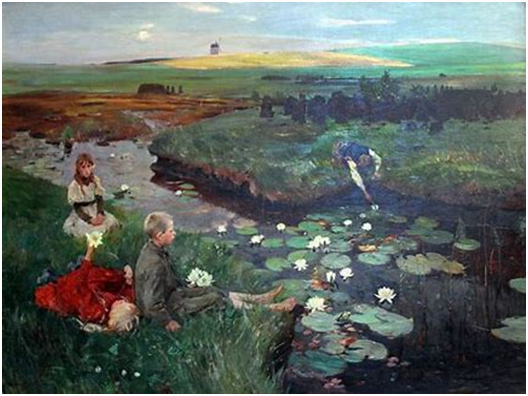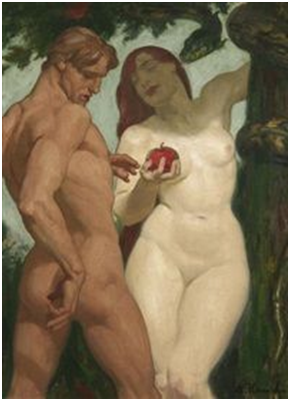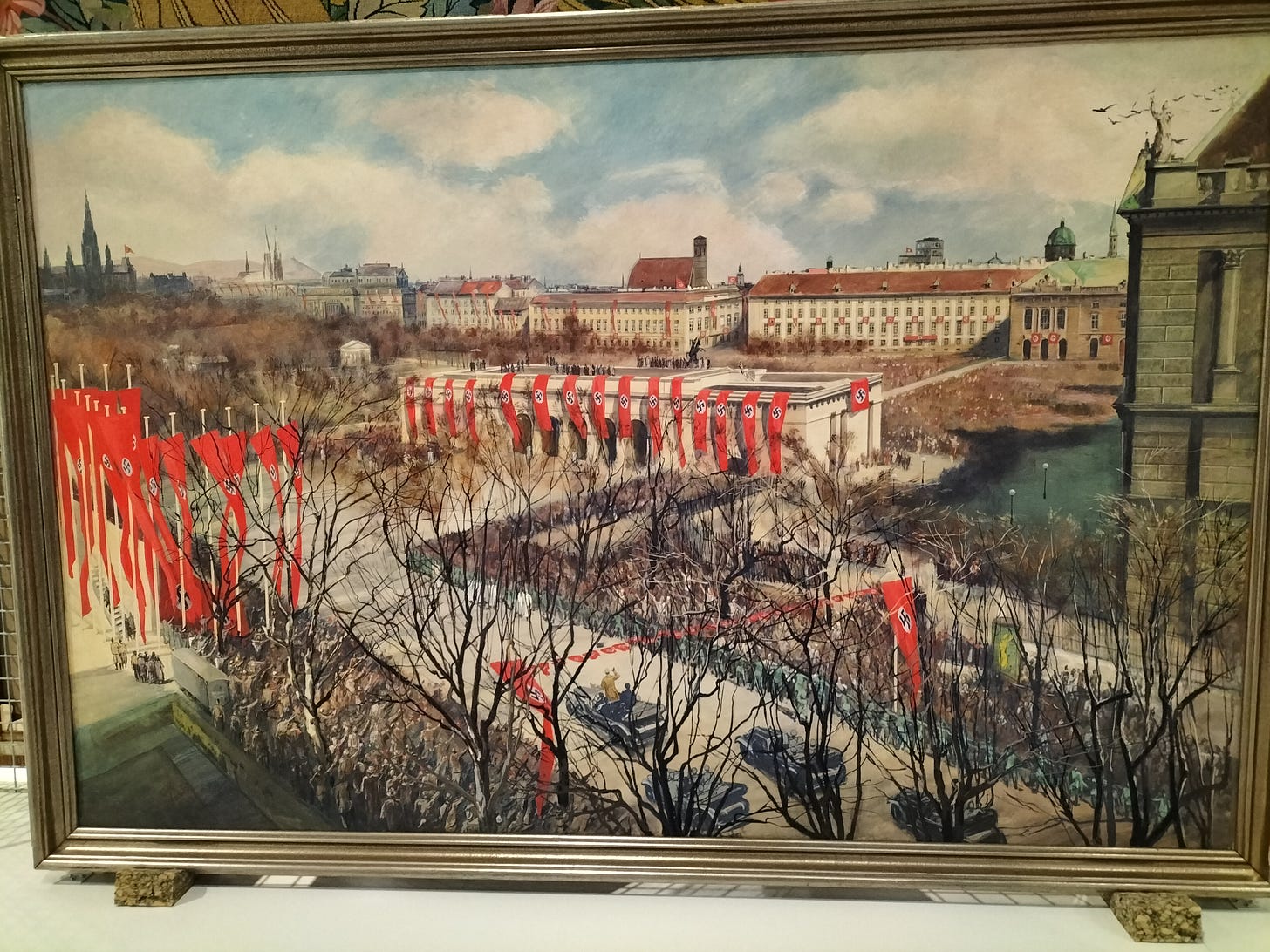Do you like this painting?
I’m not wholly convinced - it seems a little twee and the perspective slightly askew - but I don’t dislike it. If I saw it in a gallery I would give it the due Frolesworth (i.e. the minimum time it is necessary to spend frowning in deep concentration at each picture in an art gallery in order that everyone else doesn't think you're a complete moron).1
All right then, what about this?
I prefer this, not (or not solely) for the obvious reason but because I prefer the style and I admire the presentation of the theology. In terms of technique, I know about as much of art as I do of music but the application of paint seems more heroic than in the first painting.
[Now I think about it, I know very little about any technique. Many years of formal education and several advanced degrees, and all I know of prose composition or historiography could be accommodated on one sheet of A4, given a reasonably small font. Technically, I know most about acting; make of that what you will].
If you recognise these paintings, well done. If you don’t, and I’m assuming you don’t, consider your opinion and then further consider: would your opinion change if you knew the artists were Nazis?
Ludwig Dettmann (b. 1865), painter of ‘By the Waterlilies in the Moor’ (first image) and Arthur Kampf (b. 1864), painter of ‘Der Sundenfall’ (second image) joined the NSDAP after Hitler came to power; sucking up to those in power is not unknown for artists even today.2 They were exhibited as ‘Great German Art’ (as opposed to ‘Degenerate Art’, a competing exhibition that the Nazis, with characteristic cunning, staged as a method of making money by sneering) and in 1944 added to the Gottbegnadeten list of artists regarded as indispensable to National Socialist culture.3 Kampf, indeed, was a member of the elite 24-person pantheon (22 men and 2 women) of national treasures.
If you happen to be, or know anyone who might happen to be, applying to Oxbridge this year (or another random institution that conducts interviews), make sure that you or they consider this question, which is always pertinent and - to use a hideous phrase I deeply dislike - ‘today, more than ever.’ It would be useful for History of Art, Literature, History, probably Philosophy and whatever SPS4 at Cambridge is calling itself these days. It was always a wallflower subject when I was there, but I suspect it’s all the rage these days.5
‘Is the political affiliation of the artist crucial to [your understanding of] the work?’ or some variant thereof is always a good question. The paintings above are not evidently Nazi paintings and you would never have known they were by Nazis unless you’d been told. Indeed, they were painted before National Socialism was a thing, so they are not Nazi in any conceivable manner.
This, on the other hand…
Now, this is by neither Dettmann nor Kampf but it is clearly an artist not inclined to disguise a partiality for National Socialism. One could argue - and perhaps after 1945 the artist did - that this was mere documentary of Hitler’s entry into Vienna in 1938, but it seems unlikely that this painting will be prominently displayed any time soon.
(As you’re now asking the obvious question, when I visited Vienna there was an exhibition of artistic responses to the Anschluss).
I don’t think that painting is an artistic triumph, but what if it had been? To put it bluntly, how much slack is given to genius?
To throw in a hypothetical, what if those flags displayed the hammer-and-sickle and the painting documented Stalin’s triumphant entry into Vienna? (yes yes, I know there was no such event but it’s relatively easy to imagine).
Imho, the three questions above come to the same conclusion: your genius will not be excused if your opinion is unacceptable.
You won’t be at all surprised to learn that I’ve read quite a lot of German History and the tone of the authors when writing about Culture in the Third Reich varies from contempt to condescension. The assumption is always that artistic talent is inimical to National Socialism, which doubtless makes the chapter easier to write. One can afford a little light scorn when discussing artists who bent the knee to the regime - specifically, to that regime. Only very rarely do authors take the time to address the talent of artists and the extent to which that may have been prostituted for the exigencies of living and working in the Third Reich. After all, one would hate the readers to suspect any grain of sympathy for anything that happened under Hitler.
The best (if that’s the word) example of an artist who flirted with the Nazis and produced good work was the composer Richard Strauss. The most problematic was Leni Riefenstahl, whose genius was such that the AMPAS recognised her in its annual In Memoriam tribute at the Oscars. There are no famous Nazi writers because, of course, writing is the most obvious art form; if you write as a Nazi, it’s difficult to abjure after the event. But it’s not necessarily the case that they were all rubbish. I’m not going to spend the next few months chasing down these authors and judging their ability, but I do wonder how bad they are. This is all the more interesting because artists in the twentieth century could and did profess support for communist regimes without incurring any harm to their reputation - quite the opposite, indeed. And no, I haven’t forgotten McCarthy and HUAC but nobody has even stricken, say, Pablo Neruda from the canon because he supported the Soviet Union crushing the Hungarian Uprising in 1956. Paul Robeson didn’t have an easy life but not everybody wrote “through his deep humanity, by his wise understanding, he leaves us a rich and monumental heritage” about Stalin.
(To take a homely example, a former colleague had a Che Guevara mug. Students were allowed to display the flag of the USSR in their rooms. On the 100th anniversary of the Representation of the People Act, the school flew the green-white-violet suffragette flag, which is admittedly not promoting a ruthless ideology but was as embarrassing a display of literal virtue-signalling as one could possibly imagine).
You know perfectly well that this tendency is on the flood tide. Artistic works are being defaced, sometimes literally, not because they are the third painting but because the creators may once have done something that somebody today doesn’t much like. From 2018:
“Students have defaced a mural featuring Rudyard Kipling's If in a stand against his "racist" work.
The author's 1895 poem was painted on a wall of Manchester University's newly renovated union building.
But student leaders erased the work, replacing it with a piece by Maya Angelou in a bid to reverse "black and brown voices" being written out of history.
The union has apologised for failing to consult students on its choice of poem.”6
So many things are wrong here that I simply don’t have time, but if history tells us anything it is that the appearance of the phrase student leaders is a sign that you should run very hard and very fast in the opposite direction. I will mention merely that students at Katharine Birbalsingh’s (majority ‘black and brown’) Michaela School in Brent regularly recite ‘If’, that Kipling is a much more interesting poet than the students at supposedly-good Manchester seem to realise and that Maya Angelou many be many things, including a devotee of Shakespeare, but a good poet is not one of them.
To be fair, it’s only some students at supposedly-good Manchester, but it only needs to a few for the others to get the point. Gradually, some works and ideas are erased. It starts with a ‘curriculum audit’7 and ends somewhere round here:
“The first tenet of critical race theory is that the United States as constructed is irreversibly racist. So if the nation-state as constructed is irreversibly racist, then it must be done with, it must be overthrown, right. And so we can’t be like, “Oh no, critical race theory is just about telling our stories and divers[ity].” It’s not about that. It’s about overthrow. It’s insurgent. And we, we need to be, I think, more honest with that. … You can’t be a critical race theorist and be pro-U.S. Okay, it is an anti-state theory that says, The United States needs to be deconstructed, period.”
So says Brian Lozenski, the man tasked with implementing ‘Ethnic Studies’ in all school curricula in the Minnesota state system.
The question of artists with unpleasant opinions or lives is genuinely complex, still more if they produce brilliant but unpleasant works of art. It’s good for an Oxbridge interview. But I really don’t think that the answer is to remove all Dettmann and Kampf from the walls.
The Meaning of Liff, Douglas Adams & John Lloyd
To be clear, I am not equating any contemporary government with the Nazis.
Perhaps the shortest-lived list in artistic history?
Social & Political Sciences.
Paging Jonathan Haidt!
Manchester students deface poem by 'racist' Kipling - BBC News
We had to conduct a ‘curriculum audit’ at my former employer, and it is difficult to imagine a more fatuous, facile and anti-intellectual endeavour. I know perfectly well it was just a matter of asses being covered, but once the principle is admitted it becomes increasingly difficult to oppose.




